
* Both the French and the British developed their own carrier-based antisubmarine warfare (ASW) aircraft in the postwar period. The French Breguet Type 1050 "Alize (Tradewind)" provided over 40 years of service to the French Navy's air arm, the Aeronavale, and the type was also used for over two decades by the Indian Navy. The British Fairey "Gannet" had a number of ingenious features, and served both in the ASW and airborne early warning (AEW) roles with the Royal Navy Fleet Air Arm. This document provides a history and description of the Alize and Gannet.
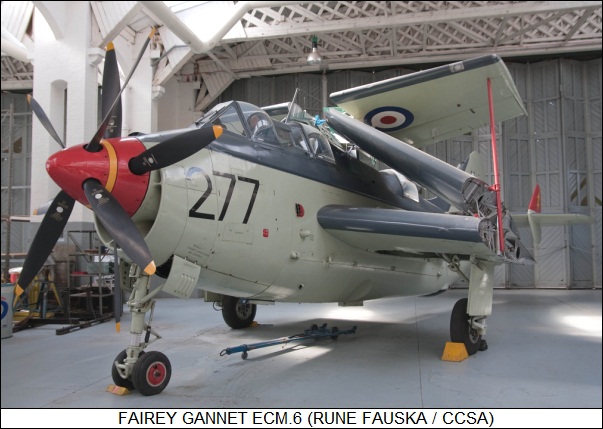
* In 1948, the French Breguet firm began work on a new carrier-based attack aircraft for the Aeronavale, the French naval air arm. The first prototype of this design, the Breguet "Type 960-1 Vultur", flew on 3 August 1951.
The Br.960-1 was powered by an Armstrong Siddeley Mamba A.S.Ma.1 turboprop engine with 730 kW (980 SHP), mounted in the nose and driving a four-bladed propeller for cruise flight, plus a Rolls-Royce Nene 101 centrifugal-flow turbojet with 21.6 kN (2,200 kgp / 4,850 lbf) thrust, fitted in the tail for take-off and combat power. The Vultur's Nene engine was license-built by Hispano-Suiza. The Br.960-1 was followed by a second prototype, the "Br.960-2", which first flew on 15 September 1952. It was powered by a Mamba A.S.Ma.3 turboprop with 985 kW (1,320 SHP) and a Nene 103 turbojet with 22.3 kN (2,270 kgp / 5,000 lbf) thrust.
The Vultur was a low-wing aircraft, with the wing featuring a swept leading edge and a straight trailing edge, folding at the middle. The aircraft had tricycle landing gear, with the main gear hinged in the wings just inside the wing fold and retracting towards the fuselage, and the nose gear retracting backwards.
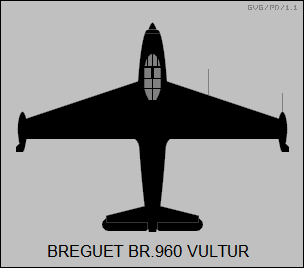
The Vultur accommodated a pilot and copilot sitting side-by-side in a framed canopy. A typical warload was a single 1-tonne (2,200-pound) bomb and eight rockets. It was fitted with radar in a pod on the right wingtip, balanced by a fuel tank on the left wingtip. A large search radar could also be attached under the fuselage.
___________________________________________________________________
BREGUET TYPE 960-2 VULTUR:
___________________________________________________________________
wingspan:
16.54 meters (54 feet 3 inches)
wing area:
36.53 sq_meters (393 sq_feet)
length:
13.21 meters (43 feet 4 inches)
height:
5.16 meters (16 feet 11 inches)
max loaded weight:
9,780 kilograms (21,560 pounds)
maximum speed:
895 KPH (555 MPH / 485 KT)
cruise speed:
370 KPH (230 MPH / 200 KT)
cruise endurance:
4 hours
___________________________________________________________________
However, Aeronavale brass decided that they were more interested in a carrier-based ASW aircraft. The Vultur never entered production, instead being extensively redesigned for the ASW role as the Breguet "Type 1050 Alize", which performed its first flight on 5 October 1956. It appears that one of the Vultur prototypes was modified to act as a systems testbed for the Alize and designated "Type 965", but details of this aircraft are unclear.
BACK_TO_TOP* The Alize ended up looking much different from the Vultur. The general configuration was similar, but the turbojet was deleted from the rear fuselage, to be replaced by a CSF-built radar system with a retractable antenna dome in the belly. The Mamba turboprop was replaced by a Rolls-Royce Dart RDa.21 turboprop with 1,565 kW (2,100 SHP), driving a four-bladed propeller.
The fuselage was extensively redesigned and enlarged to accommodate more gear and a crew of three, including pilot, radar operator, and sensor operator. The pilot was seated in front on the left, the radar operator in front on the right, and the sensor operator sat sideways behind them. The landing gear was modified so that the main gear retracted forwards into nacelles in redesigned wings. The main gear had dual wheels, and the front part of the nacelles accommodated sonobuoys (sonar buoys). The Alize had a yoke-style arresting hook.
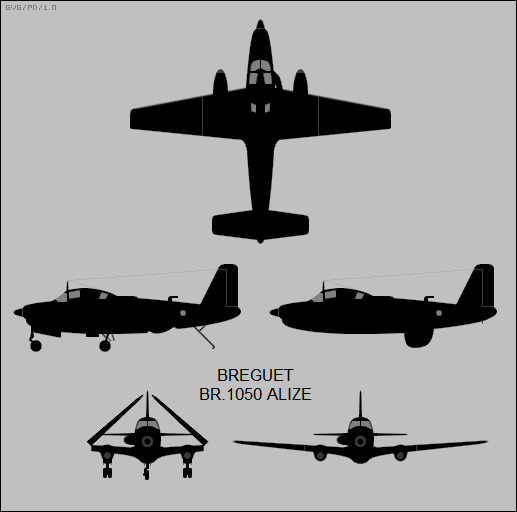
The internal weapons bay could accommodate a homing torpedo or depth charges, and underwing stores pylons could carry bombs, depth charges, rockets, or missiles. Typical underwing stores included 68-millimeter unguided rocket pods or AS-12 wire-guided antiship missiles.
___________________________________________________________________
BREGUET BR.1050 ALIZE:
___________________________________________________________________
wingspan:
15.6 meters (52 feet 2 inches)
wing area:
36 sq_meters (387.5 sq_feet)
length:
13.86 meters (45 feet 6 inches)
height:
4.75 meters (15 feet 7 inches)
empty weight:
5,700 kilograms (12,570 pounds)
normal loaded weight:
8,250 kilograms (18,100 pounds)
maximum speed:
475 KPH (295 MPH / 265 KT)
service ceiling:
6,250 meters (20,500 feet)
endurance:
> 5 hours
___________________________________________________________________
A total of 89 examples of the Alize was built between 1957 and 1962, including two preproduction prototypes. 75 production aircraft were acquired by the Aeronavale, with initial service delivery in March 1959. The Alize went into operation on the carriers CLEMENCEAU and FOCH, and was also used in shore-based training. 12 were acquired by the Indian Navy. Some sources say that there were five preproduction prototypes, which may mean some of the prototypes were brought up to production standard and passed on to the Aeronavale; and that India acquired 17 examples, which hints that they bought five used aircraft from the Aeronavale.
The Indian Navy operated the Alize from shore bases and from the carrier VIKRANT. The Alize was used for reconnaissance and patrol during India's 1961 occupation of Portuguese Goa, and was also used for ASW patrol during the Indo-Pakistan War of 1971, during which one Alize was shot down by a Pakistani F-104 Starfighter. The Alize dwindled in numbers in the Indian Navy during the 1980s, was relegated to shore-based patrol in 1987, and was finally phased out in 1991, being replaced in their duties by ASW helicopters.
* The Aeronavale provided the Alize with a series of upgrades. A modernization program performed in the early 1980s refitted 28 of the aircraft to the "Br.1050M" standard, featuring improved Thomson-CSF Iguane radar as used on the Atlantique NG ocean-patrol aircraft, new OMEGA radio navigation gear, and a new ARAR 12 radar & radio location ("electronic support measures / ESM") system.
Another upgrade program in the early 1990s fitted 24 of these aircraft with a new decoy system; a microcomputer-based data processing system that could have hardly been imagined when the aircraft was new; a datalink system; and other new avionics. Later in the decade, they were also fitted with the Thomson-CSF TTD Optronique Chlio forward-looking infrared (FLIR) imaging sensor. Despite the upgrades, by this time the Alize was clearly not up to the task of hunting modern nuclear submarines, and so it was tasked with ocean surface patrol.
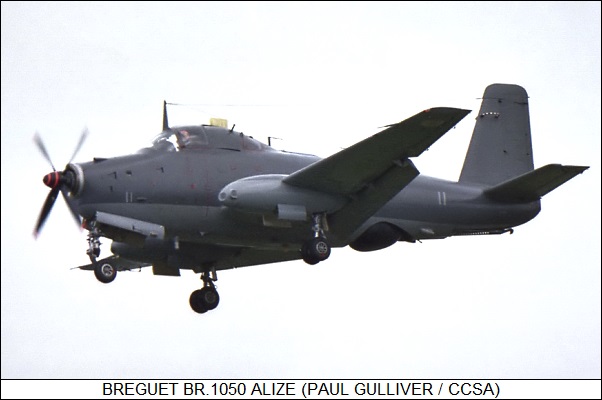
As late as 1997, the Aeronavale was still operating 24 examples for surface patrol, though they were clearly on their way out by then. The Alize was used operationally during the NATO air campaign against Serbia over Kosovo in the spring of 1999, with the aircraft flying off the carrier FOCH. The last Alize was finally withdrawn from service in 2000 with the retirement of the FOCH.
BACK_TO_TOP* During World War II, the British Royal Navy's Fleet Air Arm (FAA) found that carrier-based aircraft were an extremely capable weapon for ASW. In the postwar period, the FAA felt the need for a more capable ASW aircraft, with the result being the issue of a "GR.17/45" requirement for a carrier-based ASW aircraft in 1945.
The US Navy was focusing on "hunter-killer" teams of aircraft at the time, with one aircraft carrying search radar and other sensors to locate a submarine, and the other to carry rockets, depth charges, and homing torpedoes to sink it. That arrangement was partly due to the fact that the sensors were very bulky at the time, making carriage of both sensors and weapons on the same machine unreasonable for a carrier-based aircraft. The GR.17/45 requirement was more ambitious, possibly too much so, specifying a single two-seat aircraft that could act both as hunter and killer. Both Fairey and Blackburn submitted designs for the competition, and in August 1946 were both awarded contracts for two prototypes from each company.
* The Fairey submission was originally designated the "Fairey Q" or "Fairey 17", after the requirement, and performed its initial flight on 19 September 1949. It was a hefty aircraft, with a barrel-like fuselage to accommodate sensors and weapons, and was powered by the Armstrong-Siddeley Double Mamba turboprop engine.
The Double Mamba was what would now be called a "twinpac" engine, with two turboprop engines driving a common gearbox, which in turn drove a contra-rotating propeller system with four blades per propeller. One of the turboprop engines could be shut down for economical cruise flight, and if one of the engines failed, the aircraft would not suffer the handling problems associated with asymmetric power. The Fairey 17 did suffer from some handling problems, but they were corrected through a few aerodynamic modifications, and carrier deck trials began in the spring of 1950, with the Fairey 17 performing the first landing of a turboprop aircraft on a carrier, the HMS ILLUSTRIOUS, on 19 June 1950.
* The Blackburn submission was designated the "B-54" or "YA.7". It was of similar configuration but powered initially by a Rolls-Royce Griffon piston engine with 1,492 kW (2,000 SHP) driving contra-rotating propellers, the Napier Double Naiad turboprop intended to power the original "YA.5" design having been canceled. Initial flight was on 20 September 1949, a day after the flight of the Fairey 17.
Then the Admiralty changed the direction of both programs by adding a new requirement for area search radar and three seats. Blackburn responded with a second prototype, the "YA.8", with the three seats and a retractable "dustbin" radome under the tail. The wings and tail were modified to deal with the aerodynamic changes. It retained the Griffon engine.
The YA.8 led to a third prototype, the "B-88" or "YB.1", which was similar but had a Double Mamba engine. It performed its first flight on 19 July 1950. This aircraft had a wingspan of 13.46 meters (44 feet 2 inches); a length of 13 meters (42 feet 8 inches); a height of 5.11 meters (16 feet 9 inches); a maximum take-off weight of 5,940 kilograms (13,090 pounds); a top speed of 515 KPH (320 MPH); and an endurance of over three hours. The gull wings had a double fold mechanism for compact carrier stowage.

* The request to add radar and a third seat had also led Fairey to build a third prototype with the necessary changes, which performed its first flight on 10 May 1951. Although the Blackburn and Fairey designs were very comparable and in fact similar in many ways, the Fairey submission won the award, to be given the name "Gannet", with an Admiralty order for a hundred aircraft. The three Blackburn prototypes did continue to fly as test and trials aircraft for a few more years.
The ambitious nature of the Gannet led to various development hangups, but the first production "Gannet AS.1 (Anti-Submarine Mark 1)" flew in October 1953 and finally entered FAA service in 1955, almost ten years after the issue of the initial requirement.
BACK_TO_TOP* The Gannet was a tubby aircraft, generally regarded as ugly but to some eyes endearing, like a quirky wind-up toy. The fuselage had a big weapons bay to accommodate two torpedoes or other stores, for a total of 900 kilograms (2,000 pounds) of munitions, and a retractable radome for search radar under the rear fuselage. The Gannet could be also be fitted with underwing stores pylons to carry rocket projectiles or sonobuoys.
The Double Mamba Mark 100 twinpac engine provided a total of 2,200 kW (2,950 SHP), with the exhausts behind the wings. As noted above, the wings were gull-shaped and had a double "scissors" fold to allow them to meet carrier elevator width and hangar height limits. Addition of an extendable dustbin radome for the search radar had led to some lateral instability, and so auxiliary finlets were fitted to the tailplane late in development to fix the problem. The same effect could have been obtained by raising the height of the tailfin, but that option ran into hangar height limits.
The Gannet had tricycle landing gear, with twin-wheeled nose gear retracting backwards and single-wheel main gear retracting from the wings toward the fuselage. The aircraft had a stinger-type arresting hook. The Gannet's three crew sat in tandem, with pilot, observer-navigator, and radio-radar operator in their own cockpits, the radio / radar operator's seat facing the tail of the aircraft. The third prototype had differed from this configuration in placing both the "back seaters" in a single cockpit.
A total of 181 Gannet AS.1s was built. A "Gannet T.2" conversion trainer was also developed to familiarize pilots with the eccentricities of the Double Mamba relative to a piston engine, and teach them how to handle antisubmarine munitions. The T.2 featured a flight instructor in the middle cockpit with full backup flight controls and a periscope for forward view. The radar was deleted, but the rear cockpit was retained for a radio operator. The first T.2 performed its initial flight on 16 August 1954, and 38 were built.
In 1956, an improved Double Mamba Mark 101 twinpac engine with 2,265 kW (3,035 SHP) was introduced into Gannet production. The designation of aircraft fitted with this engine was updated to "Gannet AS.4", with initial flight in 1956; and "Gannet T.5", with initial flight in 1957. 75 AS.4s and 8 T.5s were built in all, while some existing AS.1s and T.2s were also updated with the improved engine.
___________________________________________________________________
FAIREY GANNET AS.4:
___________________________________________________________________
wingspan:
16.57 meters (54 feet 4 inches)
wing area:
44.85 sq_meters (482.8 sq_feet)
length:
13.1 meters (43 feet)
height:
4.17 meters (13 feet 8 inches)
empty weight:
6,590 kilograms (14,530 pounds)
loaded weight:
10,200 kilograms (22,500 pounds)
max speed, sea level:
480 KPH (300 MPH / 260 KT)
service ceiling:
7,620 meters (25,000 feet)
range:
1,520 kilometers (945 MI / 820 NMI)
___________________________________________________________________
A number of Gannets were obtained by foreign air arms. The Royal Australian Navy ordered 40 Gannets in late 1952, with deliveries beginning in 1955. Only 36 were actually delivered, including 33 AS.1s and three T.2s. They flew off the carrier MELBOURNE and from shore bases. The West German naval air arm, the MarineFlieger, obtained 15 AS.4s and a single T.5, operating them from shore bases since the MarineFlieger didn't have any carriers, being focused primarily on shore defense.
The Australian and German Gannets were all new-build aircraft, included in production totals given previously. Indonesia also obtained 16 AS.4s and two T.5s, rebuilt from Royal Navy AS.1s and T.2s.
* The British FAA had operated the Douglas AD-4W Skyraider airborne early warning (AEW) aircraft, and to replace the Skyraiders awarded Fairey a contract to adapt the Gannet to the role. The result was the "Gannet AEW.3", which first flew in August 1958. Although the original idea was a "minimum modification" of the Gannet AS airframe, as often happens in such circumstances one thing led to another, with the airframe being largely redesigned.

The pilot cockpit was moved forward, and two radar operators were seated in the rear fuselage, with side doors for access. The exhausts for the Double Mamba were moved up in front of the wing to make space for the radar operators. There was a large radome under the fuselage, fitted with AN/APS-20 radar salvaged from the FAA Skyraiders and flanked by extended stalky landing gear to provide clearance for take-off. The tailfin was raised in height to aerodynamically compensate for the radome.
The Gannet AEW.3 was powered by a Double Mamba Mk.102 twinpac engine with 2,890 kW (3,875 SHP). Initial flight was in August 1958. A total of 44 was built into 1961, by which time Fairey had been absorbed into Westland. The final Gannet AEW.3 was rolled out in December 1962, and was the last fixed-wing aircraft built by the company. Total Gannet production was 349 aircraft, including prototypes.
* By the end of the 1950s, the Royal Navy was beginning to see the utility of helicopters such as the Whirlwind for fleet ASW defense, and the AS.1 and AS.4 were out of fleet service by mid-1960. Some AS.4s were modified to an electronic countermeasure (ECM) trainer configuration and redesignated "ECM.6", apparently also referred to as the "AS.6". Others were modified to a "carrier onboard delivery (COD)" cargo and personnel transport configuration and redesignated "COD.4". Some sources also mention an "AS.7" update, but give no details; this variant seems to be bogus.
The ECM.6 and COD.4 served well into the 1960s. The Gannet AEW.3 served into 1977. When the AEW.3 was obsoleted, the AN/APS-20 radars were salvaged again, this time being fitted to equally antiquated Shackleton airframes to result in the Shackleton AEW.2. That was a decidedly stopgap solution until Britain obtained the Boeing E-3D AWACS aircraft from the US, and is another, somewhat untidy, story.
German Gannets were phased out in 1965, to be replaced by the Breguet Atlantique. The Australian Gannets were phased out in 1967, to be replaced by the Grumman S-2 Tracker. Gannets served as industry test and trials aircraft for a time after their military service, with one being used by Hamilton Standard in the US for propeller design evaluation work. That was the only Gannet to fly in American service. A number of Gannets survive on static display, but none are flightworthy.
* A total of 349 Gannets was built in all. The following list summarizes Gannet variants & production:
* One of the footnotes to the Gannet story was that the British built a second, "light" ASW aircraft in the same period, the "Short SB.6 Seamew", intended to operate off of light carriers for protection of convoys or naval battle groups. The Seamew was the result of a requirement issued by the British Admiralty in 1951, with the initial prototype flying in 1953. The prototypes were followed by a production order for 41 aircraft, including several "SC.2 Seamew Mark IIs" for the RAF.
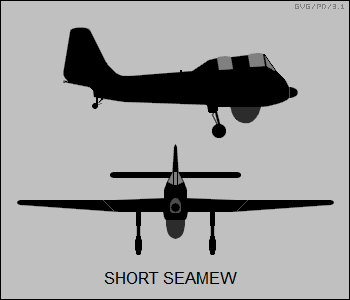
The Seamew was as odd-looking or more so than the Gannet, with a deep, relatively narrow fuselage; a two-place cockpit, perched very high to give the crew a good view; a radome directly under the cockpit; and fixed tailwheel landing gear. It had mid-mounted wings, a conventional tail assembly, and was powered by a single Mamba turboprop engine with 1,185 kW (1,590 SHP). The Seamew had a wingspan of 16.76 meters (55 feet), a maximum take-off weight of 6,800 kilograms (15,000 pounds), and a top speed of 380 KPH (235 MPH).
The Seamew's handling was said to have left something to be desired, and despite work to improve matters, the aircraft never proved very satisfactory. Only 19 of the production batch had been completed, with only seven delivered to the Royal Navy, when the program was canceled in 1957. The cancellation was apparently for reasons of cost, but it is likely in hindsight that the Seamew was bypassed by the ASW helicopter anyway.
* Sources include:
A number of websites, particularly Damien Burke's THUNDER & LIGHTNINGS site, were consulted on the Gannet. Incidentally, different sources seem to give ridiculously different numbers for Gannet production, and the figures given here have to be considered little more than a guess.
* Revision history:
v1.0 / 01 apr 01 v2.0.0 / 01 mar 02 / Added sections on Gannet. v2.0.1 / 01 apr 02 / A few typo corrections. v2.0.2 / 01 apr 04 / Review & polish. v2.0.3 / 01 apr 06 / Review & polish. v2.0.4 / 01 mar 08 / Gannet variant table. v2.0.5 / 01 feb 10 / Review & polish. v2.0.6 / 01 jan 12 / Review & polish. v2.0.7 / 01 dec 13 / Review & polish. v2.0.8 / 01 nov 15 / Review & polish. v2.0.9 / 01 oct 17 / Review & polish. v2.1.0 / 01 sep 19 / Review & polish. v2.2.0 / 01 jul 21 / Review & polish. v2.2.1 / 01 jun 23 / Review & polish. v2.2.2 / 01 jun 25 / Review & polish.BACK_TO_TOP
